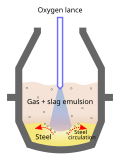This article has multiple issues. Please help improve it or discuss these issues on the talk page . (Learn how and when to remove these messages)
|
Converting is a type of metallurgical smelting that includes several processes; the most commercially important form is the treatment of molten metal sulfides to produce crude metal and slag, as in the case of copper and nickel converting. A now-uncommon form is batch treatment of pig iron to produce steel by the Bessemer process. The vessel used was called the Bessemer converter. Modern steel mills use basic oxygen process converters.





